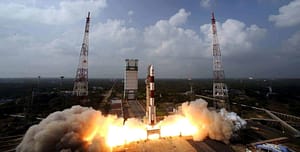Here is my piece on Marsdaily about the geopolitics of India’s Mars mission. Despite what the piece states at the top – I am NOT in Bangalore!

Not for profit website/blog on astronomy, space and my writing
By Gurbir 2 Comments
Here is my piece on Marsdaily about the geopolitics of India’s Mars mission. Despite what the piece states at the top – I am NOT in Bangalore!


India launched its Mars Orbiter Mission (MOM) with its Polar Satellite Launch Vehicle (PSLV) launcher and everything, including the weather, performed as expected. The 1340KM Mars bound probe with a 15km package of five science instruments will arrive at Mars in December next year.
Currently MOM is in Earth orbit where it will remain for another week. Why? Because the Indian Space Research Organisation (ISRO) is still working on its more powerful launcher the Geosynchronous Launch Vehicle (GSLV) so had to use the less powerful but extremely reliable PSLV. Hence the modest science package and the requirement of six orbits of Earth for gravity assist. Several engine firings on November 6, 7, 8, 9 and 11 are required, each one increasing MOM’s speed. A final burn on 16th November will finally supply it the speed it needs to reach Mars. With another critical engine burn is required for arrival in Martian orbit on 1st of December. If that burn, almost a year from now fails, MOM will fly past Mars and be lost in space.
India’s space program was founded almost 50 years ago on the principle that space technology is an essential instrument for national development. Although commercial, military and scientific elements have since crept in, improving the quality of life for the huge Indian population, remains its primary objective.
ISRO has designated this as a technology demonstrator, India is building on the its Chandryaan-1 mission from 2008 but the engineering and technical challenges are an order of magnitude higher. ISRO was successful in reaching the Moon on its first attempt, it is hoping to do likewise with Mars.
Here is a 4 minute clip of my audio interview on Voice of Russia. I am introduced as a science journalist which of course I am not.
 Book Review
Book ReviewTitle: Mars Beckons India. The story of India’s Mission to Mars
Publisher: Vigyan Pasar
Author: Srinivas Laxman
ISBN: 9788174802255
Hardback: 71 pages
Disclosure: The author of this book, Srinivas Laxman reviewed my book “Yuri Gagarin in Manchester and London” on his blog in 2011.
The dramatic announcement by the Indian Space Research Organisation (ISRO) in August 2012 to launch a mission to Mars surprised everyone. It went further. In order to catch the next Mars launch window ISRO committed to a launch in November 2013. Miss that and they will have to wait for at least two years for the next one. This is an extra-ordinarily bold undertaking for a space agency with the experience of only a single mission beyond Earth orbit under its belt.
In this book the author, a Times of India journalist, Srinivas Laxman interviews some of the key ISRO personnel to get mission details first hand. There is not a great deal of detail in the book. Given the record breaking timescale, just over a year from announcement to launch, much of the detail is work in progress. The subtitle “The story of India’s Mission to Mars” is a little ambitious given that the mission has yet to begin. In the preface the author describes the book as a “public outreach exercise” which is much more appropriate objective. The book is well produced containing a generous number colour images. Some are disappointingly small and not all sit well within the narrative where they appear.
Although far from comprehensive, this is probably the most detailed information source authorised by ISRO in the public domain at the present. It was published early 2013. Mission details are still emerging. The 500kg spacecraft called Mangalyaan in the media but not formally by ISRO nor in this book, was made by Hindustan Aeronautics Limited, will be launched aboard a PSLV-XL launcher (the same one used for the Chandrayaan-1 mission to the Moon in 2008) in November 2013. Following six ever increasing elliptical orbits of Earth, Mangalyaan will leave Earth on 26th November and enter Martian orbit of 500km by 80,000km on 21st September 2014.
This mission, unlike Chandrayaan-1 does not have an element of international collaboration. All five instruments (Methane Sensor, Thermal Infra-red Imaging Spectrometer, Mars Colour Camera, Lyman Alpha Photometer and the Mars Exospheric Neutral Composition Analyser) are of Indian origin.
Also included in the book is some background to Mars missions in the past and an introduction to some of the key ISRO personnel too. This is an ideal book for anyone new to the subject, especially students who are looking for a primer on the India’s first Mars mission. Currently it is only available in hardback. Particularly for the student community, the publisher should consider releasing an e-book version.
The book, published only in India is available online from Bookadda at RS175.
 Since the mid 1970s six spacecraft (Viking 1 & 2, Sojourner, Opportunity, Spirit and Phoenix) have successfully landed on the surface of Mars. In probably the most audacious, breathtaking and risky space missions, in less than two days, another Mars Curiosity Rover will arrive on Mars. Using a technique never used before, NASA has described the Entry Decent Landing as the seven minutes of terror.
Since the mid 1970s six spacecraft (Viking 1 & 2, Sojourner, Opportunity, Spirit and Phoenix) have successfully landed on the surface of Mars. In probably the most audacious, breathtaking and risky space missions, in less than two days, another Mars Curiosity Rover will arrive on Mars. Using a technique never used before, NASA has described the Entry Decent Landing as the seven minutes of terror.
Launched in November 2011, the arrival of Mars Curiosity will for the first time make a high precision landing which is so crucial to its primary scientific goal of finding evidence of earlier Martian environment that may have been suitable for life.
Also known as the Mars Science Laboratory (MSL) it will be supported by a pair of NASA satellites (Odyssey and Mars Reconnaissance Orbiter (MRO) already in Martian orbit. Mars has never been under so much human scrutiny. In addition to the still functioning Opportunity, a rover on the surface of Mars (launched in 2004) and the two NASA satellites, there is also the European Space Agency’s Mars Express is also in Martian orbit.
Dr Anita Sengupta is a member of the Entry Decent Landing and Advanced Technologies group at Jet Propulsion Laboratory. In this interview recorded on August 2nd via telephone from her office in JPL she captures the sheer exhilaration of the dramatic entry decent and landing phase and describes her role in the Mars Curiosity rover mission.
Podcast: Play in new window | Download (0.0KB) | Embed